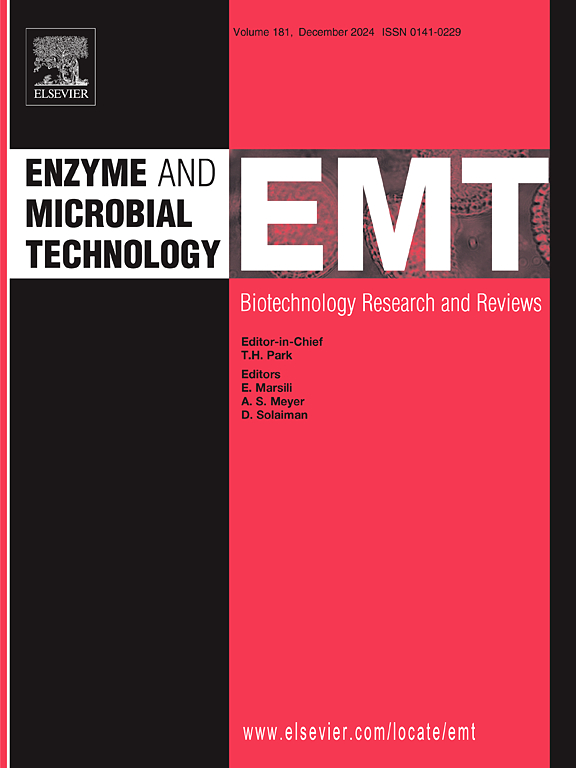Recombinant alginate lyases and mannitol dehydrogenase enhance hydrolysis of macroalgal carbohydrates
IF 3.7
3区 生物学
Q2 BIOTECHNOLOGY & APPLIED MICROBIOLOGY
引用次数: 0
Abstract
Brown macroalgae are a promising source for bioethanol production, primarily due to their high carbohydrate, low lignin and high moisture content. Bioconversion of macroalgae to ethanol requires a yeast, such as Saccharomyces cerevisiae, that can hydrolyse the macroalgal carbohydrates, namely laminarin, mannitol and alginate. In this study, the mannitol dehydrogenase (MDH) genes from Aspergillus fumigatus (AfMDH) and Talaromyces islandicus (TiMDH), and the alginate lyase (AL) genes from Sphingomonas sp. (SpxAL and SpeAL) and Talaromyces emersonii (TeeAL) were expressed in the laboratory strain, S. cerevisiae Y294. Co-cultures of a laminarinase-producing yeast, Y294[Relam1/Tvlam1] and yeasts expressing mannitol dehydrogenases and alginate lyases were evaluated for the consolidated bioprocessing of the major carbohydrates in brown macroalgae. Laminarin and mannitol were targeted for ethanol production, while alginate was depolymerised to expose mannitol. A co-culture of S. cerevisiae Y294[Relam1/Tvlam1], [AfMDH] and [TeeAL/SpxAL] strains produced 10.30 g/L ethanol from Ecklonia maxima, representing a 98 % carbon conversion (based on the laminarin and mannitol content). A strain expressing both endo- and exo-alginate lyase improved the ethanol yield by 42.28 % compared to strains expressing only laminarinase- and mannitol dehydrogenase. Scanning electron microscopy further revealed that co-cultures containing laminarinase, MDH, and AL enzymes promoted significant physical degradation and increased porosity in macroalgal substrates, suggesting enhanced alginate hydrolysis and improved enzyme accessibility. This is the first report on the simultaneous hydrolysis of mannitol, alginate and laminarin with recombinant enzymes during macroalgal fermentation. The results demonstrate significant progress towards exploiting brown macroalgae for bioconversion to ethanol and high-value products.
重组海藻酸酯裂解酶和甘露醇脱氢酶增强了大藻碳水化合物的水解
由于其高碳水化合物、低木质素和高水分含量,褐藻是一种很有前途的生物乙醇生产来源。将大型藻类生物转化为乙醇需要酵母,如酿酒酵母,它可以水解大型藻类碳水化合物,即板藻素、甘露醇和海藻酸盐。本研究在酿酒酵母Y294中表达了烟曲霉(Aspergillus fumigatus, AfMDH)和岛塔芳菌(Talaromyces islandicus, TiMDH)的甘露醇脱氢酶(mannitol dehydrogenase, MDH)基因,以及鞘氨单胞菌(SpxAL和spal)和墨氏塔芳菌(Talaromyces emersonii, TeeAL)的海藻酸解酶(alginate lyase, AL)基因。研究了一种产层状胺酶的酵母Y294[Relam1/Tvlam1]与表达甘露醇脱氢酶和海藻酸水解酶的酵母共培养对褐藻中主要碳水化合物的强化生物处理效果。Laminarin和甘露醇的目标是乙醇生产,而海藻酸解聚暴露甘露醇。酿酒葡萄球菌Y294[Relam1/Tvlam1]、[AfMDH]和[TeeAL/SpxAL]菌株共培养,从Ecklonia maxima中产生10.30 g/L乙醇,碳转化率为98. %(基于层酰胺和甘露醇含量)。与只表达层拉氨酸酶和甘露醇脱氢酶的菌株相比,同时表达内海藻酸酯和外海藻酸酯裂解酶的菌株乙醇产量提高了42.28 %。扫描电镜进一步显示,含有层状胺酶、MDH和AL酶的共培养促进了大藻底物的显著物理降解和孔隙度增加,表明海藻酸盐水解增强,酶可及性提高。本文首次报道了重组酶在大藻发酵过程中同时水解甘露醇、海藻酸盐和层状蛋白。研究结果表明,在利用褐藻生物转化为乙醇和高价值产品方面取得了重大进展。
本文章由计算机程序翻译,如有差异,请以英文原文为准。
求助全文
约1分钟内获得全文
求助全文
来源期刊

Enzyme and Microbial Technology
生物-生物工程与应用微生物
CiteScore
7.60
自引率
5.90%
发文量
142
审稿时长
38 days
期刊介绍:
Enzyme and Microbial Technology is an international, peer-reviewed journal publishing original research and reviews, of biotechnological significance and novelty, on basic and applied aspects of the science and technology of processes involving the use of enzymes, micro-organisms, animal cells and plant cells.
We especially encourage submissions on:
Biocatalysis and the use of Directed Evolution in Synthetic Biology and Biotechnology
Biotechnological Production of New Bioactive Molecules, Biomaterials, Biopharmaceuticals, and Biofuels
New Imaging Techniques and Biosensors, especially as applicable to Healthcare and Systems Biology
New Biotechnological Approaches in Genomics, Proteomics and Metabolomics
Metabolic Engineering, Biomolecular Engineering and Nanobiotechnology
Manuscripts which report isolation, purification, immobilization or utilization of organisms or enzymes which are already well-described in the literature are not suitable for publication in EMT, unless their primary purpose is to report significant new findings or approaches which are of broad biotechnological importance. Similarly, manuscripts which report optimization studies on well-established processes are inappropriate. EMT does not accept papers dealing with mathematical modeling unless they report significant, new experimental data.
 求助内容:
求助内容: 应助结果提醒方式:
应助结果提醒方式:


